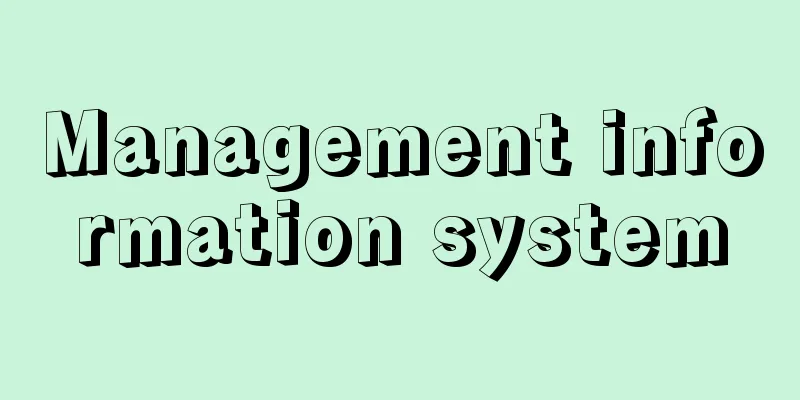Management information system

|
Abbreviated as MIS. It is a system that is organized to collect, transmit, store, and use relevant information inside and outside the business in real time, in large quantities, accurately and appropriately, as needed, in order to improve the effectiveness of management decision-making. Nowadays, it is normal for it to be a man-machine system that is composed of humans and physical means centered on computers. Since there are various types of decision making, we can think of subsystems of information systems in management corresponding to those types of decision making. The main ones are classified by hierarchy as strategic information system (SIS), management information system, and operations information system, and classified by function as information systems for finance, purchasing, production, labor, sales, etc. Among the classifications by hierarchy, the operations information system (OIS) provides data to the first two information systems and receives instructions from them. For this reason, the core of a management information system is expected to be a management information system consisting of a strategic information system and a management information system. The distinctive feature of a management information system is that it is a decision support system (DSS), and the challenges are building and maintaining the database and utilizing it in accordance with the type of decision-making (routine/operational, non-routine/strategic, etc.). The development of management information systems began with task information systems for each job function, and by organically integrating these systems, management information systems and strategic information systems have developed. The driving force behind this development has been the improvement in computer capabilities, but there have been some changes in how computers are positioned in the design of management information systems. When management information systems were first proposed, a centralized system was envisioned, with a large computer (mainframe) at its core and numerous terminals, but it did not function as expected and ended in failure. As high-performance personal computers (PCs) and office automation equipment developed, distributed systems that are closely connected to the workplace began to be promoted. The current situation is basically at this stage, but in the future, it is thought that there will be a transition to a centralized distributed system in which the entire system is online through an information processing center. In this case, centralization refers to the existence of a data bank, and distributed refers to decision-making at the workplace by using (accessing) the data bank while responding to various situations. [Mitsuo Morimoto] ©Shogakukan "> Management Information System Conceptual Diagram Source: Shogakukan Encyclopedia Nipponica About Encyclopedia Nipponica Information | Legend |
|
MISと略称される。経営の意思決定の有効性を高めるため、経営内外の関連情報を、必要に応じて即時的(リアルタイム)かつ大量に、そのうえ正確かつ適切に収集・伝達・貯蔵・利用できるよう編成したシステムをいう。現在では、人間とコンピュータを中心にした物的諸手段によって構成されるマン・マシン・システムになっているのが普通である。 意思決定にはさまざまなものがあるから、それに対応して、経営における情報システムのサブシステムを考えることができる。その主要なものは、階層別に戦略情報システム(SIS strategic information system)、管理情報システム、作業情報システムとし、職能別に財務・購買・生産・労務・販売などの各情報システムとするものである。階層別区分のうち、作業情報システム(OIS operations information system)は、前二者の情報システムに対し、データを提供し、そこから指令を受け取る。このため、経営情報システムの中核は、戦略情報システムと管理情報システムからなるマネジメント情報システムに求められる。 マネジメント情報システムの特色は、意思決定支援システム(DSS decision support system)にあり、データベースの構築と維持、意思決定の型(定型的・業務的か、非定型的・戦略的かなど)に対応したその活用が課題となる。 経営情報システムの整備は、職能別の作業情報システムから始まり、それらを有機的に統合内包しつつ、管理情報システム、戦略情報システムが発展してきた。コンピュータの能力向上がこの発展の推進力となったが、コンピュータを経営情報システムの設計にいかに位置づけるかについては若干の変遷がある。経営情報システムが提唱された初期には、大型コンピュータ(メインフレーム)を中核に置き、多数の端末機を置く集中型システムが構想されたが、期待どおり機能せず失敗に終わった。やがて性能のよいパーソナル・コンピュータ(PC)とOA機器が発達するにつれ、現場に密着した分散型システムが推賞されるようになった。現状は基本的にこの段階にあるが、今後は情報処理センターによって全体をオンライン化する集中的分散システムへの移行が考えられる。この場合、集中とはデータバンクの存在をいい、分散とは多様な状況に対応しつつデータバンクを利用(アクセス)しながら現場で意思決定が行われることをいう。 [森本三男] ©Shogakukan"> 経営情報システム概念図 出典 小学館 日本大百科全書(ニッポニカ)日本大百科全書(ニッポニカ)について 情報 | 凡例 |
<<: Business strategy - Keieisenryaku (English spelling) corporate strategy
>>: Business association - Business association
Recommend
Remnant arc (English spelling)
...Although there are no shallow earthquake chain...
Karlstadt, L. (English spelling) KarlstadtL
…His main stage was in Munich throughout his life...
Montpelier
The capital of the state of Vermont in the United ...
Scribing - Scribbling
The act of marking a workpiece to be machined or h...
Zeuxidia
...Small ones have a wingspan of about 6 cm, whil...
Dyarchy
…However, state affairs were further divided into...
Engiza
A theater located in Akasaka Tameike, Tokyo. It op...
Ezotomiyo - Ezotomiyo
...There are several species of the Three-spined ...
Busy - Busy
A game played by girls. Two girls face each other ...
Sabot - Sabot (English spelling) French
In Japan, it refers to European wooden shoes. The...
Pteropus dasymallus (English spelling) Pteropusdasymallus
…[Yoshiyuki Mizuko]. . . *Some of the terminology...
Otowa Tanshichi - Otowa Tanshichi
A title for Kabuki and Joruri. Original title Kant...
Verus, Lucius Aurelius
[Born] 130.12.15. [Death] 169 Roman Emperor (reign...
Female Gecko - Female Gecko
...They lay eggs once or twice a year, two at a t...
Common merganser (English spelling) Mergus merganser; common merganser
It is a member of the Anatidae family and is large...









